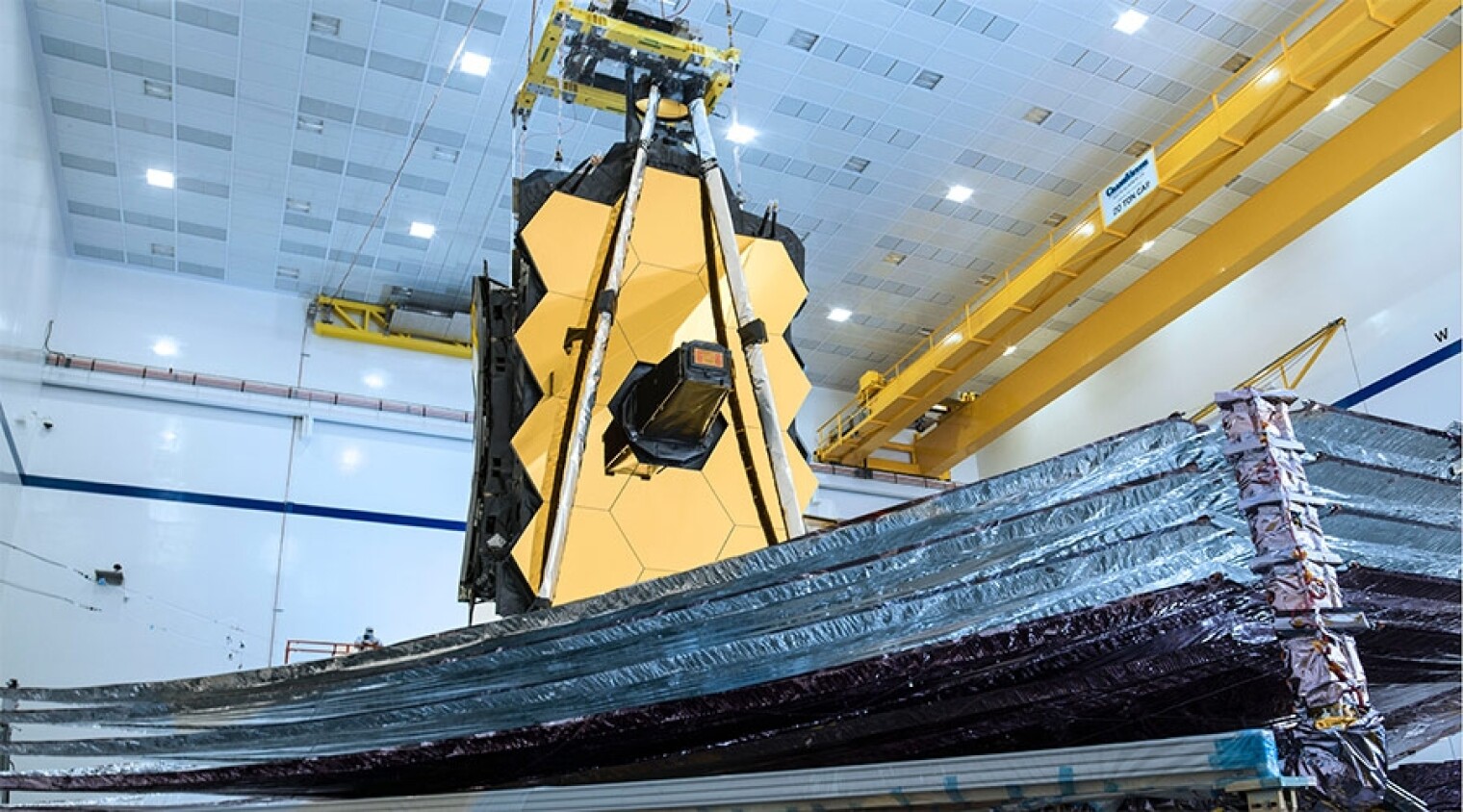| |
What’s Ahead
 |
| The James Webb Space Telescope is currently undergoing pre-launch integration and testing at Northrop Grumman Aerospace Systems in Redondo Beach, California. (Image credit – Chris Gunn / NASA) |
Space Science Week Forges Ahead Online
The National Academies is holding its annual Space Science Week meeting completely online this year due to the coronavirus pandemic. Officials from NASA and other federal agencies will update the research community on the latest developments in their programs, including disruptions owing to the current crisis. There will be a session dedicated to the status of the long-delayed James Webb Space Telescope, which is a year from its current target launch date but could now be in danger of another slippage. At the moment, Northrop Grumman, the telescope’s prime contractor, is continuing testing with reduced staff but expects the absence of NASA personnel onsite will soon force it to cease all work. Other sessions will cover matters such as progress of the Astro2020 decadal survey, small-satellite megaconstellations’ interference with ground-based astronomical observations, and the future of research on the International Space Station. In addition, the Academies’ Committee on Astrobiology and Planetary Science will gather information for a report on what sorts of proposals NASA should solicit for its next New Frontiers mission.
|
|
In Case You Missed It
 |
| President Trump signed Congress’ third coronavirus relief bill shortly after the House passed it by voice vote on March 27. The Senate approved the measure by a 96 to 0 vote earlier in the week. (Image credit – Shealah Craighead / The White House) |
Latest Coronavirus Response Legislation Boosts Research
The roughly $2 trillion coronavirus relief legislation Congress passed last week includes funding to shore up coronavirus research efforts at an array of federal agencies. Beyond providing $945 million to the National Institutes of Health and billions to other public health agencies, the legislation includes $100 million for supporting researcher access to the Department of Energy’s user facilities and computational resources, $75 million for grants issued by the National Science Foundation, and $66 million for measurement science and manufacturing programs at the National Institute of Standards and Technology. It also provides resources and authorities to cover coronavirus-related disruptions to agency activities, including by enabling agencies to reimburse contractors that pay employees who cannot work remotely. The legislation is primarily focused on providing economic aid, which includes the creation of a $14 billion relief fund for universities. That amount is well short of what university associations requested, though Congress has already indicated it plans to pursue additional coronavirus legislation, offering research organizations another opportunity to seek assistance.
More Federal Science Facilities Close Due to Coronavirus
As more states across the U.S. implemented restrictions on non-essential activities last week, another wave of federal facilities moved to minimize onsite operations. NASA’s Goddard Space Flight Center in Maryland and Glenn Research Center in Ohio are now among those that have moved to the fourth and highest stage of the agency’s emergency response framework. Among the Department of Energy’s national labs, Los Alamos National Lab in New Mexico, Jefferson Lab in Virginia, Pacific Northwest National Lab in Washington, and Idaho National Lab all announced new steps to curtail operations. Among astronomical observatories, the Gemini North Telescope in Hawaii suspended nighttime operations on March 25, and the Laser Interferometer Gravitational-Wave Observatory halted observations on March 27. LIGO has detectors in Washington and Louisiana, both states with large numbers of confirmed coronavirus cases. In addition, the European Space Agency announced on March 24 that it is scaling back operations of several spacecraft that require large staffs in their ground control centers.
NOAA Seeks Bids for Earth Prediction Innovation Center
The National Oceanic and Atmospheric Administration is soliciting bids for a contract to operate the Earth Prediction Innovation Center, a cornerstone of its effort to reclaim global leadership in weather forecasting. The agency anticipates making a single award by this fall that would provide up to $45 million over five years to operate the center. Although the solicitation notes the workforce operating the center will likely be “largely virtual,” it adds the contractor may be tasked with establishing a “physical point of presence” anywhere in the continental U.S. The House Science Committee has taken a strong interest in EPIC, and its chair and ranking member sent a letter to NOAA earlier this month urging that the request for proposals “result in a single award being issued to ensure EPIC is implemented in a unified manner that prevents fragmentation of the program.”
NSF Releases Annual Analysis of Merit Review Process
The National Science Foundation recently released its annual merit review digest, providing data on the nearly 50,000 research proposals submitted to the agency in fiscal year 2018. The report states that the agency funded 24% of proposals across all research areas, consistent with success rates over the last few years. It also states the funding rates for women and underrepresented racial and ethnic groups are similar to the overall funding rate. In a preface to the report, the National Science Board draws attention to how 1,835 proposals, together requesting about $1.5 billion, were rated “Very Good” or higher but did not receive funding due to lack of resources. The board argues that increasing NSF’s budget is warranted, writing, “a funding rate closer to the historical average of 30% or more would be beneficial to the long-term health of the research community and to the nation as a whole.”
Scrutiny of NOAA Weather Satellite Programs Continues
The Commerce Department Office of Inspector General announced last week it has initiated an audit of the National Oceanic and Atmospheric Administration’s geostationary satellite acquisition program, focusing on the agency’s progress toward launching its GOES-T mission. The satellite’s anticipated launch has been delayed after problems were experienced with a key instrument aboard GOES-17 (formerly called GOES-S), the second in NOAA’s series of next-generation geosynchronous weather satellites. Last August, NASA and NOAA released a joint investigative report on the issue, concluding the problem was likely caused by a pipe blockage resulting from a “design issue or failure on-orbit.” Though the instrument is still able to provide 97% data availability, it fails to meet the requirement that data outages last no more than six hours per year. On March 24, the inspector general office also released an audit report on NOAA’s Joint Polar Satellite System program, which is scheduled to launch the second satellite in its series in 2022. The report states the cost of the JPSS-2 spacecraft increased 12% to $273 million between 2015 and 2019 primarily because of changes made to the payload’s interface electronics to mitigate schedule risk.
Science Committee Focuses In on Innovation in Nuclear Site Cleanup
On March 25, the chair and ranking member of the House Science Committee asked the Government Accountability Office to evaluate the Department of Energy’s efforts to clean up hazardous waste across its lab complex and legacy nuclear weapons production sites. Citing a 2019 National Academies study, they state that DOE’s Office of Environmental Management has substantially reduced investments in cleanup science and technology development over the past two decades, focusing instead on deploying existing technologies. They also highlight that the study recommended the office work with the Advanced Research Projects Agency–Energy to develop “breakthrough technologies” that could increase the efficiency of cleanup efforts. Accordingly, the committee asks GAO to assess the office’s current processes for identifying S&T development priorities, the extent of its collaboration with other DOE offices and outside stakeholders, and the resources needed to support S&T development.
|
|
Events This Week
All times are Eastern Daylight Time and all congressional hearings are webcast, unless otherwise noted. Listings do not imply endorsement.
Monday, March 30
Tuesday, March 31
Wednesday, April 1
Thursday, April 2
Friday, April 3
No events.
|
|
Opportunities American Physical Society Hiring CEO
The American Physical Society is seeking its next chief executive officer to “advance the mission of the world’s leading physics professional society with a budget of $68 million, leading and managing more than 55,000 members and 250 staff.” The posting states that top candidates will be qualified scientific leaders that have “knowledge of the U.S. legislative process, science policy, and global scientific collaboration.” Submissions are due April 30.
EPA Accepting Input on Revised Science Transparency Rule
The Environmental Protection Agency is accepting public comments on revisions to its proposed transparency rule that would restrict the agency from using certain scientific studies that lack publicly available data. As part of the changes, EPA proposes to expand the scope of the public access requirement, applying it to “influential scientific information” in addition to significant regulatory decisions. Comments are due April 17.
Carbon Capture Policy Fellowship Seeking Applicants
Carbon180 is accepting applications for a new one year senior policy fellowship position based in Washington, D.C. The fellow will work on “creating new, science-driven, inclusive policies to scale carbon removal to the gigaton level.” Applicants must hold an advanced degree in a related field. Applications are due April 3.
Know of an upcoming science policy event either inside or outside the Beltway? Email us at fyi@aip.org.
|
|
Around the Web
News and views currently in circulation. Links do not imply endorsement.
White House
Congress
Science, Society, and the Economy
Education and Workforce
Research Management
Labs and Facilities
Emerging Technologies
Space
Weather, Climate, and Environment
Energy
Defense
Biomedical
International Affairs
|
|
|
| |
| |
|
